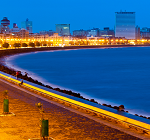At the just concluded meeting of the leaders of the BRICS nations in Fortaleza in Brazil this week, the New Development Bank, first institution to represent the grouping was formalised, in leadership, content and physical location. The location is to be Shanghai, the content will be infrastructure and sustainable development project lending, and the presidency will vest with India.
That an ambitious, $100-billion institution has been concretised by the developing world for its own needs, is good. But it is a pity that Shanghai has been selected to host the bank. For Shanghai is now like London – developed and first world, with Western-level aspirations that have long ago left the third world behind. The bank that is to be an alternative to that very West, will now operate administratively in the politically closed state of China, which has never masked its ambitions to dominate BRICS.
The more appropriate and natural choice for locating the bank would have been Mumbai. There are several reasons why.
First, this would be the first multilateral institution to be located in India. With it would have come an engagement with international leaders and the practice of economic diplomacy. Mumbai is a microcosm of the developing world. With its urbanisation, population, poverty and security challenges, it is a perfect laboratory for the bank.
It is also a dynamic mix of finance, business, advertising and media, the film industry, art, IT, international back-office operations. And it has manufacturing hubs in its hinterland of Pune and beyond that, Gujarat. Mumbai’s public transport overall is among the country’s best, the Tata companies provide 24-hour electricity and it is also one of the safest cities for women – a necessary ingredient for multilateral talent.
When India threw its hat into the ring for the location selection for the bank, the government recommended Delhi. But that would have made the bank into yet another hub for recycled bureaucrats. Instead, it would have had a better chance with Mumbai, a city revelling in the fresh ideas and talent of a hard-driving, youthful private sector and whose financial and international linkages have been embedded in its DNA for over 300 years.
For Mumbai has always been India’s connector to the world, an open city with myriad foreign influences. For centuries, its docks sent out and received the ships in the spice trade and later, the cotton and opium trade – the latter with Shanghai, then a closed city in the introverted Middle Kingdom which built a Great Wall around itself to keep out foreign influences. The British Empire’s West Asian foreign policy was run out of Mumbai, and till 1956, the Rupee was legal tender in many parts of that region – all regulated by the Reserve Bank of India.
Today, Mumbai is the financial capital of India. Its financial eco-system is the most sophisticated of any other city in BRICS – financial entrepreneurs, private banks, central bankers, stock brokers, venture capitalists, private equity, fund managers abound, mostly all successful. Mumbai is host to the Reserve Bank of India, the most well-respected and trusted central bank in the BRICS, or even in Asia. The People’s Bank of China doesn’t compare.
The Bombay Stock Exchange, running strong, is the oldest stock exchange in Asia, or even the other BRICS. Mumbai is India’s premier port, and the headquarters to the largest number of corporations in India, all of which add to the country’s revenues and business dynamism.
Finally, India is the ‘I’ in the centre of the acronym. Logistically, Mumbai is within an eight-hour radius of all the other BRICS countries except Brazil, and has overlapping working hours with all save Brazil. Shanghai is at one extreme geographic end of the BRICS.
A physical location is available for the BRICS bank in Mumbai: Along the eastern seaboard of the city, in the 773 acres of heritage port area along the Victoria and Princes Docks which are up for redevelopment. The BRICS development bank could have been located next to the Reserve Bank of India, which could have been the fair, intellectual anchor of the institution. Like the United Nations which is located along New York’s East River, so would the BRICS development bank – and all the related BRICS institutions to come – have been located along the city’s picturesque eastern sea board on the Arabian Sea.
There is already a plan in place, the Percy Committee Report of 2007, on making Mumbai an International Financial Centre. It has been gathering dust, but it could just as easily gather support. The city’s businesses and the central government are ready for it. Linking that with the plan to build out the Bangalore-Mumbai corridor will give it a perfect ending – or beginning: developing the eastern seaboard like London’s Dockyards and Canary Wharf.
This is a plan that the Indian government should have backed – and particularly Modi who is looking to galvanise our cities and create jobs.
What’s left now is to get the right candidate from India to head the BRICS bank. Mumbai, again, has plenty of the requisite talent, which also has a compassionate heart to lead the first independent developing countries’ financial institution. Hopefully our Prime Minister will make a visionary choice – one that will give him instant global leadership status, far beyond just the BRICS.
Manjeet Kripalani is the Co-founder and Executive Director of Gateway House: Indian Council on Global Relations.
This article was first published by the Financial Times here.
You can read more exclusive content from Gateway House here.
For interview requests with the author, or for permission to republish, please contact outreach@gatewayhouse.in.
© Copyright 2014 Gateway House: Indian Council on Global Relations. All rights reserved. Any unauthorized copying or reproduction is strictly prohibited


